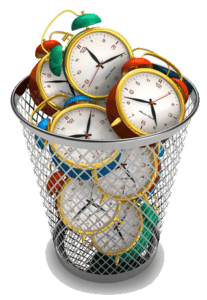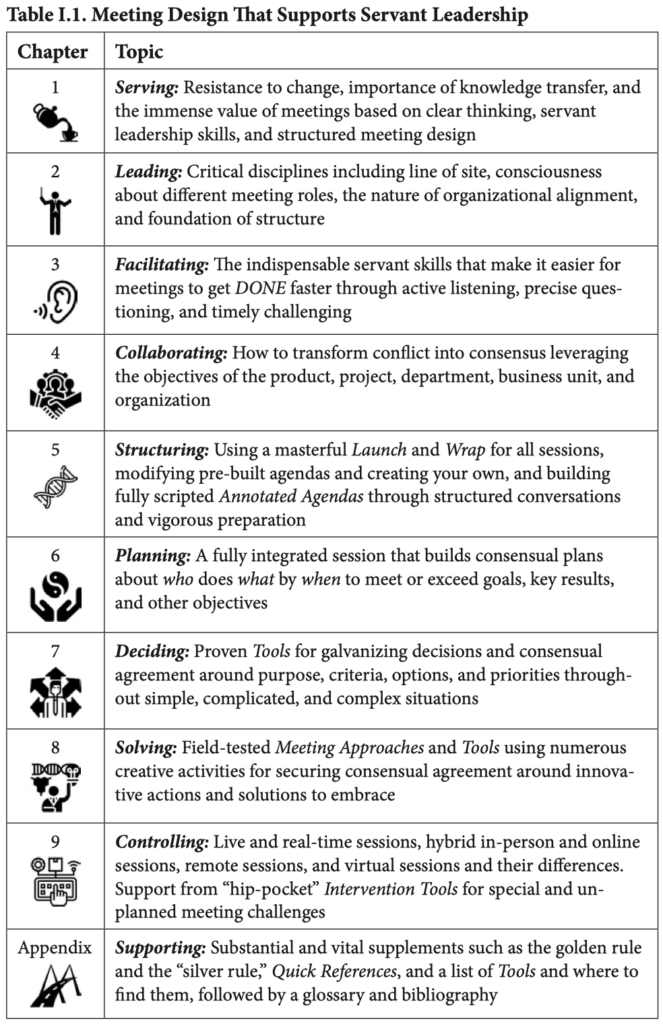The Purpose
There’s nothing more frustrating than an unproductive meeting—except one that leads to another unproductive meeting. Which is why I wrote Meetings That Get Results. Developed from over 17+ years of research, delivery, and practice, including 15,000+ hours providing live instruction using a certified curriculum, this practical, comprehensive facilitator’s guide is for the millions of people right now who are out there leading meetings without any training in facilitation or meeting design. Within the book’s pages, you’ll learn how to ensure your meetings produce clear and actionable results—meetings that are profitable and productive—and that ultimately lead to fewer meetings.
In addition to basic information-exchange meetings (such as staff meetings and board meetings), “Meetings That Get Results” focuses on three important forms of meetings:
- Decision-making—focusing on prioritization and ranking
- Planning—that is, consensual agreement and shared ownership (who does what by when?)
- Problem-solving—for example, focusing on innovative solutions during the meeting
It’s All About You
I understand that in a world of back-to-back meetings, you barely have time to find the right resources and training to become a better leader. Yet, while you would not attempt to build a boat without the proper training, equipment, and support, every day millions of people are conducting meetings without a critical understanding of or formal training on how to be an effective meeting leader in person or online. Meetings whose deliverables affect tens, hundreds, or even thousands of jobs, or determine the success or failure of a department or company, regularly cost organizations more money than all the boats, ships, and skyscrapers being built today. This book gives you a significant edge:
- Empowering you to help your groups create, innovate, and break through the barriers of miscommunication, politics, and intolerance.
- Making it easier for you to help others reach consensus and shared understanding, while never yielding to the easy answer.
- Providing you with specific Agenda Steps and Tools to avoid the worst possible result of any meeting: another meeting.
MAKING IT EASY
Facil in Latin means “easily accomplished.” The word facilitaera evolved from the Latin verb facilius reddo, meaning “easily accomplished or attained.” When a group of subject matter experts manages to stay focused, miracles can happen. Therefore, I define business facilitation as a method that removes all distractions, making it easy or attainable for a group of experts to gain traction by focusing on the same question at the same time, led by a meeting facilitator who knows how to sequence questions, ask questions with precision, and guide consensual understanding and agreement around optimal solutions for that specific group of experts.
THE TOUGH PART
Rarely do events, meetings, or workshops proceed in a linear fashion. They don’t just “start here” and then “end there.” Rather, they continually loop and twirl—for reasons such as these:
- Someone joins the meeting late, online or in person.
- A subject matter expert gets called away unexpectedly and upon return discovers some critical information missing.
- You are asked to go back and add something.
- Someone changes her mind because her introspection has found a connection between a few things previously not considered.
- Someone comes back from break with added information obtained from an outside subject matter expert or from the internet.
- You are asked to substitute or combine something.
- Someone wakes up and cannot understand something decided earlier.
- Two people start arguing because they refuse to agree with each other based on “principle.”
- You need to fully define something.
- You do a poor job handling participants’ electronic leashes (cell phones, laptops, etc.) and when everyone wakes up, they quickly unravel what has already been accomplished.
Sound familiar?
If so, the remedies in this book are meant for you. I cannot promise you a method to resolve everything you encounter in meetings. But this book does provide a method and additional confidence to manage anything that develops or erupts during your meetings.
When you see the term “meetings” you might substitute the generic term “sessions.” Meeting leadership skills allow you to pivot among ceremonies, conferences, events, meetings, and workshops—wherever groups assemble in session to decide, plan, prioritize, and solve problems. I want to make it easier for you to be a credible meeting leader and meeting facilitator[♠] when leading diverse types of meeting sessions, for all types of groups, organizations, teams, and tribes.[♦]
RELAX
The style of this facilitator’s guide supports quick reading and cross-referencing. Conventions include the following:
- Lists of items (such as bullet points) are typically alphabetically ordered. If not, lists are sorted by chronology, dependency, frequency, or importance (impact).
- Meeting Approaches, Agenda Steps, and Tools appear in italics, with cross-references to the chapters or sections where they appear.
LEGACY
Like you, I know how it feels to sit in a meeting and think, “What a waste of the organization’s time and money.” To solve this problem, I’ve spent years improving a structured method to design and lead better meetings. Once you have read this book, you will have the knowledge I wish I had earlier in my career. The book is the result of more than 15,000 hours invested in training thousands of people on four different continents. These people now plan and run better meetings using disciplined, holistic meeting design, based on proven techniques such as structured conversations, with an ever-vigilant eye toward decision quality and collaborative ownership.
How to Navigate This Facilitator’s Guide to Meeting Design
- Read the first four chapters to understand and reinforce meeting leadership; the core skills and discipline of effective facilitation; and how to manage group collaboration, meeting conflict, and personality dysfunction. When you need a refresher, refer to the table of contents to isolate the topic you need to reinforce, such as “How to Manage Arguments.”
- For your meetings and events, use the Quick Reference sections and Tool selection guide at the end of the book to remind you about suitable activities for structuring your agenda and meeting design. The Quick Reference sections prompt you with detailed instructions to use when building your Launch, Agenda Steps, and Wrap (fully detailed and scripted in Chapter 5).
Facilitator’s Guide Chapter Summary
- For specific agendas, tools, and procedures to use repeatedly when conducting meeting sessions, turn to these chapters (also see the summary table below)
- Planning sessions—Chapter 6
- Decision-making and prioritization sessions—Chapter 7
- Problem-solving and innovation sessions—Chapter 8
- Online sessions and differences—Chapter 9
- Staff meetings and other information-exchange sessions—Chapter 9
- Board meetings and “Robert’s Rules” situations—Chapter 9
- After identifying your situation and locating the appropriate Agenda Steps, adapt the prescribed procedures to your personal taste and environmental constraints by considering the following factors:
- Duration or amount of available time
- Monetary impact of your meeting deliverable on organizational objectives
- Number of participants, expected and optimal
- Physical space or online ease of using breakout rooms
- Your ability to adapt the tools to both in-person and online settings
- Your experience and confidence with the recommended tools
Facilitator’s Guide Scripting and Support
- Script your Annotated Agenda (chapter 5) from start to finish. For best results, follow the seven activities of a professional Introduction (Launch) using the prescribed sequence. Script them and follow your script. According to New York Times best-selling author Daniel Pink,[♣] the four activities of a professional Conclusion (Wrap) are even more important than a smooth Launch. So thoroughly prepare for your four concluding Review and Wrap activities, which ensure clear and actionable results.
- Prepare your participants. For major initiatives or workshops, send out a Participants’ Package (chapter 5). For 50-minute meetings, prepare a one-page description of the meeting purpose, meeting scope, meeting objectives, and basic agenda.
- Once your Annotated Agenda (Chapter 5) is complete, and even while you are working on it, prepare supplementary material and visual support such as a glossary, slides, legends, posters, and screens (illustrated throughout this book) to help you explain the tools and procedures you will use to build deliverables and get DONE.
[♠] The meeting facilitator represents one of four roles performed by the meeting leader; the other three roles commonly performed by the meeting leader include meeting coordinator, meeting documenter, and meeting designer.
[♦] Teams reassemble every season with new players. Tribes stay together through thick and thin, over the long haul.
[♣] Daniel Pink, When: The Scientific Secrets of Perfect Timing (2018).
______
Don’t ruin your career by hosting bad meetings. Sign up for a workshop or send this to someone who should. MGRUSH workshops focus on meeting design and practice. Each person practices tools, methods, and activities daily during the week. Therefore, while some call this immersion, we call it the road to building high-value facilitation skills.
Our workshops also provide a superb way to earn up to 40 SEUs from the Scrum Alliance, 40 CDUs from IIBA, 40 Continuous Learning Points (CLPs) based on Federal Acquisition Certification Continuous Professional Learning Requirements using Training and Education activities, 40 Professional Development Units (PDUs) from SAVE International, as well as 4.0 CEUs for other professions. (See workshop and Reference Manual descriptions for details.)
Want a free 10-minute break timer? Sign up for our once-monthly newsletter HERE and receive a free timer along with four other of our favorite facilitation tools.
Go to the Facilitation Training Store to access proven, in-house resources, including fully annotated agendas, break timers, and templates. Finally, take a few seconds to buy us a cup of coffee and please SHARE with others.
In conclusion, we dare you to embrace the will, wisdom, and activities that amplify a facilitative leader. #facilitationtraining #MEETING DESIGN
______
With Bookmarks no longer a feature in WordPress, we need to append the following for your benefit and reference
- 20 Prioritization Techniques = https://foldingburritos.com/product-prioritization-techniques/
- Creativity Techniques = https://www.mycoted.com/Category:Creativity_Techniques
- Facilitation Training Calendar = https://mgrush.com/public-facilitation-training-calendar/
- Liberating Structures = http://www.liberatingstructures.com/ls-menu
- Management Methods = https://www.valuebasedmanagement.net
- Newseum = https://www.freedomforum.org/todaysfrontpages/
- People Search = https://pudding.cool/2019/05/people-map/
- Project Gutenberg = http://www.gutenberg.org/wiki/Main_Page
- Scrum Events Agendas = https://mgrush.com/blog/scrum-facilitation/
- Speed test = https://www.speedtest.net/result/8715401342
- Teleconference call = https://youtu.be/DYu_bGbZiiQ
- The Size of Space = https://neal.fun/size-of-space/
- Thiagi/ 400 ready-to-use training games = http://thiagi.net/archive/www/games.html
- Visualization methods = http://www.visual-literacy.org/periodic_table/periodic_table.html#
- Walking Gorilla = https://youtu.be/vJG698U2Mvo

Terrence Metz, MBA, CSM, CSPF, PSP01, HTTO1, is the Managing Director of MG RUSH Facilitation Leadership, Training, and Meeting Design, an acknowledged leader in structured facilitation training, and author of “Meetings That Get Results – A Facilitator’s Guide to Building Better Meetings.” His FAST Facilitation Best Practices blog features nearly 300 articles on facilitation skills and tools aimed at helping others lead meetings that produce clear and actionable results. His clients include Agilists, Scrum teams, program and project managers, senior officers, and the business analyst community among numerous private and public companies and global corporations. As an undergraduate of Northwestern University (Evanston, IL) and an MBA graduate from NWU’s Kellogg School of Management, his professional experience has focused on process improvement and product development. He continually aspires to make it easier for others to succeed.



